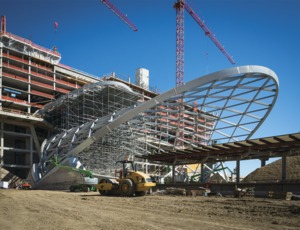
For ENR's Top 500 Design Firms, 2014 was a tumultuous year. It was a year when some of the nation's largest firms became even larger through the continual consolidation that the design profession has undergone over the past decade. It was also a year in which finding the ways and means of securing financing for desperately needed infrastructure work became paramount. And it also was a year when global economic upheavals were a cause for concern for many firms.
The evidence of this upheaval can be seen in the data from ENR's Top 500 Design Firms list. Taken as a group, the Top 500 firms had design revenue of $92.30 billion in 2014, down 0.4% from $92.69 billion in 2013.
Market growth was steady on the domestic side, rising 2.2%, to $66.16 billion, in 2014, up from $64.13 billion in 2013. However, revenue from projects outside the U.S. fell 8.5%, to $26.14 billion in 2014, down from $28.55 billion in 2013.
Ironically, part of this drop in revenue can be traced to one of the biggest stories of 2014: industry consolidation. In 2014, Canadian design giant WSP acquired Parsons Brinckerhoff. PB reported $924 million in international design revenue on last year's list. However, this year, WSP | Parsons Brinckerhoff U.S.'s international revenue is not accounted for in the Top 500 as it is now considered a subsidiary of a non-U.S. design firm. (PB's total international revenue will be included with WSP's revenue on the Top International Design Firms list, which will be published in July.)
Consolidation
Industry consolidation was the major issue among the Top 500 in 2014. The biggest news of 2014 was the acquisition of last year's No. 3 firm on the Top 500, URS Corp., by the No. 1 firm, AECOM, to create the first $10-billion design firm. WSP's acquisition of PB also was big news, as was Amec's acquisition of Foster Wheeler. Other big acquisitions included Arcadis-RTKL acquiring giant architectural firm Callison, which ranked at No. 73 on last year's Top 500, and POWER Engineers' acquisition of Burns and Roe Group, which ranked at No. 100 last year.
The merger of AECOM and URS is now nearly complete, with only a few areas, such as a consolidation of the accounting systems, remaining to be finalized, says Tom Bishop, president of AECOM's design and consulting business and former executive chairman of URS. "We have held hundreds of meetings across both companies and have had a terrific response," he says.
The combined firms will present a wider range of services and open up new opportunities, Bishop says. "When you couple AECOM's design capabilities with URS's construction experience, along with the financing power of AECOM Capital, we can provide full design-build-operate-maintain services. That puts many projects we were not able to pursue in the past squarely in our sweet spot," he says.
Another major change was Amec's acquisition of Foster Wheeler. "The merger is coming along very well," says Simon Naylor, Amec Foster Wheeler's president for the Americas. He says the merger will provide customers in the energy sector with Amec's upstream expertise along with Foster Wheeler's downstream experience, "allowing us to provide a truly holistic approach to our customers."
Another international firm that has made a significant impact on the U.S. market through acquisition is Australia's GHD. "In late 2011, we noticed the beginning of the downturn in Australia and, particularly, the mining industry," says Richard Wankmuller, GHD's general manager, Americas. He says the Australian market's downturn moved the firm's focus to the U.S. and Canada. Its acquisition of Conestoga-Rovers & Associates in July 2014 "provides us an increased ability to identify and hire talented people and gain access to clients across all five of our market sectors—water, property and buildings, environment, energy and resources, and transportation," says Wankmuller.
Many other firms are looking to expand. "We have not been that acquisitive in the past few years, but we are now looking at more options to acquire," says Todd Wager, president of Parsons Transportation Group.
Most executives in the industry believe consolidation will continue. "Consolidation is not finished," says Greg Graves, CEO of Burns & McDonnell. He says many large firms think they need to grow faster and that the easiest way to grow is through acquisition, although the market it good now. "We are constantly being called by consulting firms, asking if we are interested in buying firms or selling ourselves to other firms," says Graves. "We are interested in acquiring firms, but only if it makes sense for our firm and our markets."
For many firms, the trend toward consolidation is a threat. Some midsize design firms believe they will have problems competing against megafirms. But others see it as an opportunity. "Consolidation is transforming the industry," says Chris Vincze, CEO of TRC Cos. "But at the moment, some of these big firms are going to spend their time and efforts on integration, while we will be spending our time and effort marketing and serving our customers," he says.
Vincze also notes that much of the consolidation has come from companies in Europe and Asia. He says that some international firms, particularly from Australia, have been buying U.S. firms in the water and wastewater space. "With the growing strength of the dollar against the euro and other currencies, it is going to be a lot more expensive to acquire U.S. firms. On the other side, buying international firms with U.S. dollars got a lot cheaper," states Vincze.
TRC also has been making small, strategic acquisitions. In September, it acquired NOVA Safety & Environmental, a Midland, Texas-based safety and hazardous-waste firm. "This gives us a presence in the Permian basin," Vincze says.
Pressure on Fees
The pressure on design fees continues as a hangover from the recession, when firms were bidding for any work to stay afloat. "The marketplace remains very competitive, and downward pressure on fees continues to be a strong headwind," says Timothy Dufault, CEO, Cuningham Group Architecture.
Many firms worry that clients are too focused on costs. "When I started in the business in the 1970s, most of our utility customers had CEOs who were engineers who understood the value of quality engineering. Now, the CEOs are mostly finance people who are mostly concerned with the bottom line," says Dennis DeCosta, president of Commonwealth Assocates Inc.
This focus on cost has led to many design firms to seek efficiencies in the construction process. The market remains fiercely competitive, with many clients emphasizing cost efficiency and employing professional procurement and cost management to drive down prices throughout the supply chain. To stay competitive, professional services firms are having to find ways to lower their costs without undermining quality control.
For some firms, that means passing on projects where price is paramount. "We prefer not to play in the commoditized, low-fee marketplace, where long-term value may be sacrificed for bottom-line capital costs," says Dan Noble, CEO of HKS.






Post a comment to this article
Report Abusive Comment